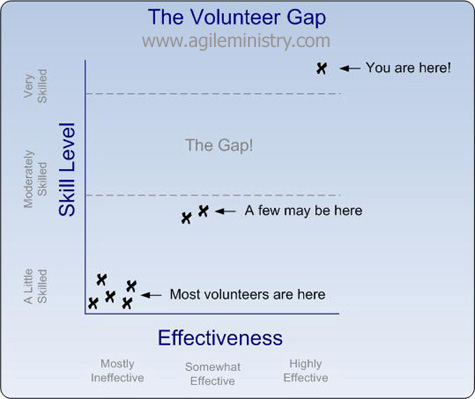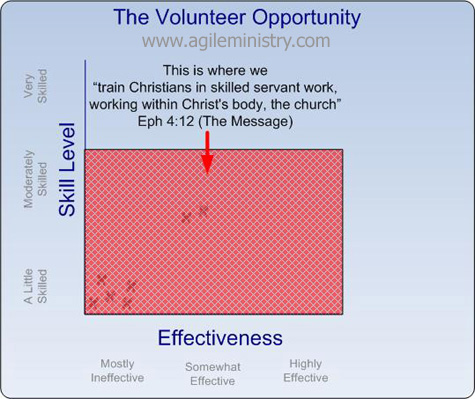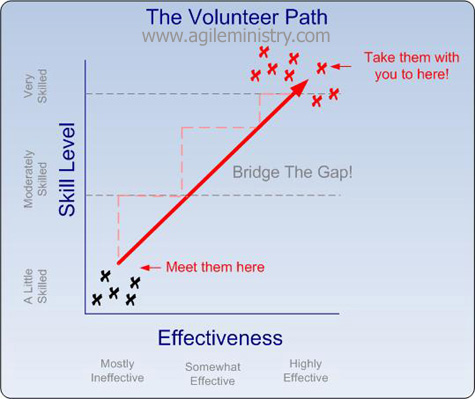Growing Your Ministry Through…Volunteers
I’ve seen some recent posts from church staff bloggers that talk about how managing volunteers can be difficult and often will slow down your ministry. I want to address this issue in this blog post by first saying: You are correct! It is hard to manage volunteers, and often is the case that the staff will discount the help of volunteers. Rather, they will take the route of doing it themself, even if it takes time away from their family or another calling. I have 3 diagrams to illustrate some principles for growing your ministry through volunteers. The first, below, shows the gap between the skilled leaders and staff and the volunteer base within the church:

As you can see, the diagram shows a few moderately skilled volunteers that may show up from time-to-time. I refer to these skilled volunteers as “heros”, as the staff and lay leaders often start to get “hero worship” when they depend on these “servant powerhouses”. While this is a great blessing, it isn’t the norm, as most volunteers fall into the lower category where they have little skills and effectiveness but a desire to serve. Keep this picture in your head, as it will help you truly meet volunteers where they are, not where you wish they were. The next diagram shows the real opportunity that exists when we realize where our volunteers actually are:

Here is where executing what the Bible says gets a little harder. You see, Eph 4:12 says, “…train Christians in skilled servant work, working within Christ’s body, the church…” We, as lay leaders and volunteers, are called to train our brothers and sisters in serving the Lord. When we opt out of training volunteers because it takes too much time, we are cheating ourselves and those that would serve with us. As I mentioned in a , we need to invest in people, not tasks. This is where true ministry is, but often we can forget this when we are leaders of a service-focused ministry such as IT, media, worship, greeting, ushering, and others. The final diagram shows what your ministry may look like after investing in your volunteers:

As you invest in them, you bridge the gap that exists between you and them. You are beginning to train them in the skills they need, but more importantly, you are increasing their effectiveness. When this happens, you will find opportunities to fine-tune your ministry to accommodate their skills while ensuring that they are effective. I’ve posted about this before when I simplified the technology choices for creating the church website. This enables you to take on more strategic steps to leading your ministry, as well as giving you more freedom to take on new opportunities as you are called.
So, whenever you feel like you are getting bogged down by working with volunteers, take heart – Paul assures us that it is the right thing to do so that “we’re all moving rhythmically and easily with each other, efficient and graceful in response to God’s Son, fully mature adults, fully developed within and without, fully alive like Christ. ” (Eph 4:13-14, The Message). Now, go grow your ministry through volunteers!
[tags]volunteering, volunteer management, church leadership[/tags]
Popularity: 1% []

[...] the lower category where they have little skills and effectiveness but a desire to serve. read more Technorati tags: non-profit, [...]
[...] the lower category where they have little skills and effectiveness but a desire to serve. read more Technorati tags: non-profit, [...]
Hello, James,
Nice post and useful graphics to illustrate the gap and the goal.
I’m an organisational consultant by profession as well as a worship leader and developer of church leaders. Our local church (in the U.S.) has grown from 25 to nearly 3000 worshippers over the past 25 years. Here’s what I think I’ve learned about the gap:
1. Churches are about relationships. The gaps begin to close when current leaders begin to disciple others one-on-one.
2. Those personal relationships build maturity and confidence that allow people to move into bigger roles–and help them want to move into them.
3. When we ask for volunteers, that’s what people think they are and behave accordingly. When we ask for leaders the same thing happens.
4. This is the tough one. In order to build lay leaders, the staff need to assume the role of spiritual mentors while the lay leaders actually lead the ministries.
5. It is time consuming at the outset. However, the multiplication process ultimately allows staff to focus on even bigger issues because they’ve built a foundation of mature leaders who then begin to build new ones.
Keep up the fine work!
Steve
Steve,
Thanks for reading my blog and for your lessons learned. You have given me some new things to think about as well!